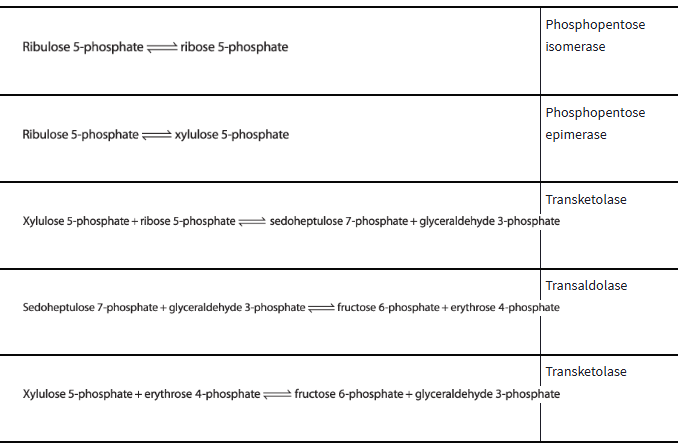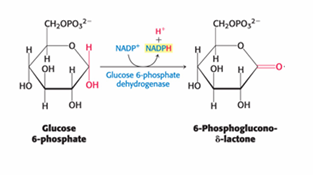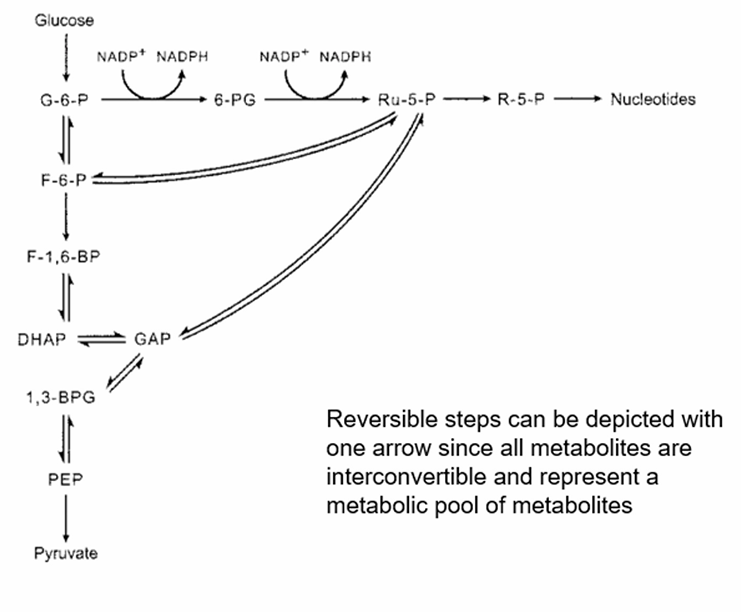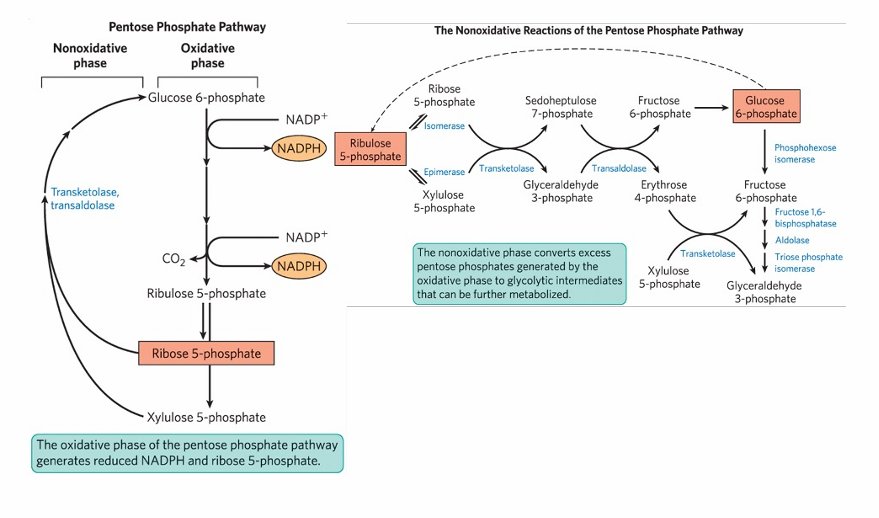Exam 2 biochemistry Pentose Phosphate Pathway /Glucogen/Fats
1/54
There's no tags or description
Looks like no tags are added yet.
Name | Mastery | Learn | Test | Matching | Spaced |
|---|
No study sessions yet.
55 Terms
Pentose Phosphate Pathway
Another way to OX glucose to CO2
Converts G6P to ribose 5 phosphate via oxidative pathway (CYTOPLASM)
Glycolysis for PPP
Produce ATP and carbon fragments to oxidize Co2 in citric acid cycle
Pentose phosphate pathway reducing power
NADPH, and CO2 is molecular precursors
Purpose of Pentose Phosphate Pathway
alternative way OX glucose
Produce pentose for nucleotide synthesis
Produce NADPH
Pentose phosphate Oxidative
Produce 2 NADPH and Pentose Phosphates
Pentose phosphate NONoxidative
Produce phosphorylated sugars
Converts pentose phosphate in excess back to glycolic intermediates (F6P, G6P, GAP)
Transketolase and Transaldolase
First Step of PPP
Irreversible and rate determining step (Oxidative phase)
G6P+ NADP+ to 6 phosphoglucono-s-lactone + NADPH + H
Enzyme: G6P dehydrogenase
Reversible/Oxidative PPP

Irreversible/Nonoxidative PPP

First step PPP Picture

PPP and Glycolysis
Both START with G6P
- Coordinately controlled

4 modes of operation PPP
1- more ribose 5 phosphate than NADPH
2- needs for NADPH and ribose 5 phosphate balanced
3- more NADPH needed
4- BOTH nadph and ATP required
Reactive oxygen species (ROS) defense system
G6P dehydrogenase and Glutathione
Generated by oxidative metabolism and damage macromolecules
Glutathione=Antioxidant
Reduced version= tripeptide with SH group, reduces ROS
Oxidized version regenerates reduced version
Reduced glutathione is regenerated by
NADPH
Oxidized glutathione reduced to reduced glutathione using NADPH depending enzyme glutathione reductase
NADPH regenerated by G6P dehydrogenase
maintains levels of glutathione to combat oxidative stress(ros), proper reducing environment in cell
Antioxidants
PICTURE OF PPP

G6P dehydrogenase deficiency (dh is dehydrogenase)
Human genetic disease
Hemolytic anemia from lack of NADPH production
Lack of NADPH production
Results in increased reactive oxygen species and oxidative damage
Fava beans, infections, drugs trigger hemolytic anemia
Antimalaria drugs and sulfa drugs
Four fates of G6P
1- Metabolized by glycolysis
2- Converted into glucose by liver/kidneys, release into bloodstream
3- Enters PPP to yield NADPH and ribose derivative
4- Synthesize glycogen in liver/kidneys
Liver Glycogen
Controlled release of Glucose: maintain blood glucose
- Glycogen degradation/synthesis happens with G6P-tase (irreversible)
Muscle Glycogen
Sudden energy source (exercising)
-Glycogen metabolized without O2
-Glycogen synthesis/degradation don’t go through G6P-tase (so its in both process)
Glycogen degradation
Releases energy (exergonic) where glucose released from glycogen (NO ATP USED)
Glycogen break down in liver/muscle
Glycogen synthesis
Consume energy (endergonic) 1 ATP and 1 UTP consumed per glucose
Glycogen degradation enzyme activity
Degrade glycogen
Remodel glycogen
Isomerize G1P to G6P
release glucose in liver
Glycogen degradation enzyme step 1
Glycogen phosphorylase-Reversible
Cleaves glycogen by adding Pi called phosphorolytic cleavage of glycogen and releases G1P
Prosthetic group: Pyridoxal phosphate
N to N-1
Glycogen degradation enzyme step 2
Debranching enzyme-Irreversible
Phosphorylase cleave a-1,4glycosidic bonds until 4 residues only
Debranching enzymes transferase activity shifts from 3 glucosyl residue from branches
Debranching enzyme a-1,6-glucosidase activity degrades its bond, releasing free glucose
Glycogen degradation enzyme step 3
Phosphoglucomutase- reversible
Enzyme converts G1P into G6P and phosphoserine catalysis this step
Both glycogen metabolism and galactose catabolism
Glycogen degradation enzyme step 4
G6P-tase- Irreversible
Liver: release free glucose
Muscle: Glycogen degradation ends with G6P
Phosphorolysis advantage
1- Conserve energy
Product G1P into G6P without ATP in phosphoglucomutase step
2-Mobilization
glycogen phospho. quick because no Pi in cell
3-Phosphorylated intermediate stays in cell
G6P and G1P charged, unable diffuse out of membrane
Glycogen regulation in liver/ muscle
Glycogen breakdown regulated in phospr. step as allosteric enzyme
T and R state phosphorylated, turn T or R on or off
Phosphorylated in R state (ON when cell needs energy)
Liver maintains
Glucose homeostasis, while muscle use glycose to produce energy
Glucagon vs Epinephrine needed
stimulate liver-glycogen breakdown in low blood glucose vs enhances glycogen breakdown in muscle/liver for muscle contraction
Very active
Hormones bind to specific receptors
Signal transition pathway, activation
Turn off: hormones stopped, PP1 (insulin activated) removed phospho. group from kinase
Glycogen degradation and synthesis by blood glucose
Covalent modification (phosphor.) and hormones (insulin, epineph, glucagon)
Synthesis inhibit: by hormones for glycogen breakdown
insulin stimulates synthesis: inactivate synthase kinase, PP1 activates, insulin increases
Protein kinase A controls glucagon
Fatty acids
Carboxylic acid-CH3-CH2-Methyl group
Stored as triacylglycerol: 3 fatty acids to 1 glycerol in adipose tissue
Triacylglycerol form lipid droplets in stomach
Then products carried into intestinal epithelium (absorption)
reformed and packaged into chylomicrons (into tissue)
Dietary triacylglycerols digested by pancreatic lipase
Small intestine after emulse bile salts
absorbed into intestine cells and packaged into chylomicrons for storage in adipose tissue
Endogenous triacylglycerols are broken down by lipolysis
In adipose tissue during exercise (fuel)
Hormone sensitive lipase and adipocyte triag. lipase hydrolyze and store triag. to glycerol and fatty acids
Triggered by hormones
Faty acids travel to tissue for energy (b-oxidation), to liver for GNG
Endogenous triag catabolized stage 1
Lipolysis
Hormones activate protein kinase A
Hormone sensitive lipase activated
activate adipocyte triag. lipase to break down lipids
Into fatty acids to create glycerol
Endogenous triag catabolized stage 2
Activate and transport Catabolism
Fatty acid link to CoA by CoA synthetase
Transferred to carnitine by carnitine acyltransferase
Glycerol to DHAP
Endogenous triag catabolized stage 3
Beta Oxidation (fatty acid degrade)
Oxidize, hydrate, oxidize, thiolysis (4 steps) to shorten fatty acids by 2 carbons each round
Activate fatty acids to CoA
In cytoplasm by Acyl Coa synthetase (ligase)
Fatty acid + CoA + AtP —> Fatty acyl CoA, AMP, Pi
IRREVERSIBLE
Transport fatty acids by Carnitine shuttle
Step 1: Carnitine acyltransferase 1
outer mito membrane
inhibited by malonyl CoA
Fatty acyl group from CoA to carnitine
Step 2: acyl carnitine translocase
Acyl carnitine in and carnitine out (inner membrane)
no atp
Step 3: Carnitine acyltransferase 2
INNER mito membrane
Fatty acyl group from CoA to carnitine
Beta Oxidation 4 steps
1-Oxidation dehydrogenation- irreversible
Acyl CoA dehydrogenase (redox)
2-Hydration-reversible
Enoyl CoA hydratase (lyase)
3-Oxidation
L-3-hydroxyacyl CoA dehydrogenase (redoc)
4-Thiolysis
B-Ketothiolase (transferase)
How many ATP for complex oxidation of fatty acid
2 atp activation
1 acetyl Coa: 10 atp
1 fadh2: 1.5 atp
1 nadh: 2.5 atp
Unsaturated fatty acid breakdown
Monounsaturated odd number double bonds
Cis 3-enoyl CoA Isomerase coverts cis to trans
Polyunsaturated even number double bonds
same isomerase+ 2,4 dienoly CoA convert fatty acid from trans to intermediate in beta oxidation
Synthesis(anabolism) of ketone bodies
GNG dominates with diabetes, Acetyl CoA cannot enter tricarboxylic acid cycle
Forces to create ketone bodies, acetoacetate and d-3-hydroxbutryrate
D-3-hydroxybuturate formed through reduction acetoacetate
synthesis in liver
Degradation (catabolism) of ketone bodies
Fasting state to feed heart, kidneys, brain
Hydroxybutyrate oxidized to form NADH and acetoacetate
then metabolized into 2 acetyl CoA
degrade in mitochondria
Glycogen Synthase
Transiter glucose from UDP to glycogen
Glycogenenin: catalyze formation of a-1,4-glucose using UDP until 10-20 units formed
Branching enzyme
Catalyze branching glycogen chain forming 1-6 linkage every 12-13 glucose residues
cleaves a-1,4- linkage to transfer 7 glucose residues for a-1,6- linkage
Step 1: Carnitine acyltransferase 1
outer mito membrane
inhibited by malonyl CoA
Fatty acyl group from CoA to carnitine
Step 2: acyl carnitine translocase
Acyl carnitine in and carnitine out (inner membrane)
no atp
Step 3: Carnitine acyltransferase 2
INNER mito membrane
Fatty acyl group from CoA to carnitine
Fatty acid by carnitite shuttle step 1
Carnitine acyltransferase 1
outer mito membrane
inhibited by malonyl CoA
Fatty acyl group from CoA to carnitine
Fatty acid by carnitite shuttle step 2
Acyl carnitine translocase
Acyl carnitine in and carnitine out (inner membrane)
no atp
Fatty acid by carnitite shuttle step 3
Carnitine acyltransferase 2
INNER mito membrane
Fatty acyl group from CoA to carnitine